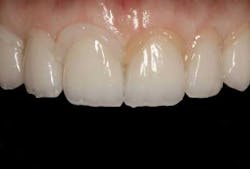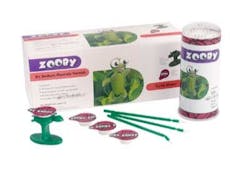Editor’s note:DentistryIQ understands that this is original research from the author that has not been published elsewhere. DentistryIQ is not a peer-reviewed publication.By Jale Özdemir, DDS, PhDAbstract: Cytotoxic impacts of calcium hydroxide and tricalcium phosphate, which are used in endodontics, have been examined in cell cultures. VERO (African Green Monkey Kidney Cell) has been used as cell culture for the cytotoxicity assessment of calcium hydroxide and tricalcium phosphate. Morphology changes, rounding and grouping of cells, have been taken into account during toxicity assessment. Toxic impact has been observed in pure concentration of tricalcium phosphate, but no toxic impact has been observed in pure concentration of calcium hydroxide when cytotoxic impacts of calcium hydroxide and tricalcium phosphate have been examined. No toxic impact has been observed in other concentrations of both substances, and it has been observed that the biocompatibility of calcium hydroxide was better than that of tricalcium phosphate.Keywords: cytotoxicity, biocompatibilityIntroductionCalcium hydroxide has been widely used in endodontic treatment since it was introduced to dentistry in 1920 by Hermann.1Calcium hydroxide is a white, odorless powder. Its formula is Ca(OH)2 and its molecular weight is 74.08. It is a substance with a pH of 12.5 and a strong alkaline nature. It is not soluble in alcohol, while it presents low solubility in water. Low solubility and hard solubility in tissue liquids when it contacts with vital tissues is a good clinical feature.2Calcium hydroxide comes out when calcium oxide contacts with water. CaO + H2O = Ca (OH)2Calcium hydroxide powder becomes paste when it is mixed with appropriate substances. For such purpose, Ringer solution, sterile saline, CMCP, distilled water, anesthetic solution, iodoform chlorothymonal, cresatine and pulpdent (methyl cellulose and calcium hydroxide) paste are being used.Calcium hydroxide becomes dissociated into Ca++ and OH+ ions in aqueous solution. Calcium hydroxide is being widely used in clinical applications due to its various biological features such as antimicrobial activity, capacity to dissolve tissues, suspending root resorption, and repairing with hard tissue formation.3Material and methodsCytotoxic impacts of calcium hydroxide and tricalcium phosphate have been examined in Vero cell culture as in vitro in our study.Assessment of cytotoxic impactVero (African Green Monkey Kidney Cell), produced with DMEM (Biochrom KG – DMEM), which contains 10% FCS (Fetal Calf Serum, Biochrom KG, Berlin), has been used as a cell culture in this research. 0.1 ml Vero cell suspension, which contains 3 x 105 cells in each milliliter of 96 celled micro-titration tablet (Falcon, Oxnard, Calif.), has been placed and incubated in the incubator, which contained 5% CO2 at 37 C°. The methodology chosen by Aydın et al. has been used as testing method after the same has been modified. Calcium hydroxide and tricalcium phosphate have been used in different ways as powder and paste for the purpose of checking the cytotoxicity of the same.0.5 grams from each of the test materials has been taken. 5 ml DMEM medium has been added and then made a suspension by using a homogenizer. This procedure has been separately repeated for all materials. The suspensions obtained have been centrifuged for 30 minutes at 5,000 rpm for the purpose of sedimenting the particles. Supernatants have been collected after the centrifuge procedure and filtered with a 0.2 µm membrane filter (Sartorius GmbH, Göttingen, Germany). Dilutions with various percentages within DMEM, which contains 2% FCS from each test material, were obtained afterward. Pure filtrate (100% concentration) has been used as a positive check (sample check) and DMEM, which contained 2% FCS, has been used a negative check (cell check). 0.1 ml from each dilution level has been transferred to two cells in which cells have been produced, after mediums in micro-titration tablet have been emptied. Also, two cells have been used as a positive check (100%) and negative check (0%). The same procedures have been repeated for other samples. Micro-titration tablets have been left for incubation in the incubator, which contained 5% CO2 at 37 C°. Toxic impacts which test materials caused changes in cell culture, which was covered as monolayer was assessed at 12-hour intervals via a tissue culture microscope (Olympus, Tokyo). Assessment was made at 12, 24, 36, 48, 60, and 72 hours. Morphology changes in cells, rounding and grouping of cells, have been taken into account as criteria during toxicity assessment. ResultsCytotoxicity resultsMorphological changes in cells of tricalcium phosphate and calcium hydroxide have been assessed in the cytotoxicity study. As result of the study, morphological changes have been observed in the cells that were around the tricalcium phosphate paste. It has been determined that they were cytotoxic. It has been observed that calcium hydroxide paste has not caused cytotoxic impact in the cells.
Figure 1.1 – Control Vero cells (x100 microscopic view )
Figure 2.1 – Tricalcium phosphate paste effects on Vero cells at 24th hour (x100 microscopic view)
Figure 2.2 – Calcium hydroxide effects on Vero cells at 24th hour (x100 microscopic view)
Figure 3.1 – Tricalcium phosphate powder pure concentration effects on Vero cells at 24th hour (x100 microscopic view)
Figure 3.2 – Calcium hydroxide powder pure concentration effects on Vero cells at 24th hour (x100 microscopic view)
As result of such assessments, no toxic impact has been observed in the pure concentration of tricalcium phosphate. No toxic impact has been observed in other concentrations of both substances, and it has been observed that the biocompatibility of calcium hydroxide was better than tricalcium phosphate.DiscussionCalcium hydroxide is widely being used in endodontic treatment. It is being used as in-channel dressing material and also in apexification treatment.Various researchers argue that different materials should be used for apexification treatment.4,5 Roberts and Brilliant6 have set out in their research that tricalcium phosphate has stimulated the apical barrier and achieved equal success with calcium hydroxide. Caviello et al.7 have set out that tricalcium phosphate has slowly been resorbed and changed place with calcified tissue.Tricalcium phosphate is efficiently being used in furcation perforations due to its biocompatibility and low inflammatory potential.8Beta-tricalcium phosphate has been used with success as an alternative to calcium hydroxide apexification in order to form an apical barrier in immature permanent teeth. Therefore, there are many studies that support beta-tricalcium phosphate use.9 However, the cost of beta-tricalcium phosphate burdens its widespread use.10In 1966, Frank has declared that calcium hydroxide apexification is a reliable and acceptable treatment approach. Frank has advised the application of calcium hydroxide and CMCP mixture to root channel.11,12,13Calcium hydroxide forms an apical barrier and also contributes to the treatment of periapical tissues.The different chemical structure of calcium hydroxide and tricalcium phosphate gives the idea that their toxic impacts on the tissues may be different from each other’s.In our study, we aimed to research the toxic impacts of calcium hydroxide and tricalcium phosphate which have been used in practice, as in vitro.Wennberg14 has used the milipore filter technique on rat fibroblast cells for the purpose of determining biological features of four different channel filling paste as in vitro.Yesilsoy and Feigal15 have examined the cytotoxicity of channel filling materials with milipore filter technique in rat fibroblast cells and in human dental pulp cells.Kawahara et al.16 have detected cytotoxic impacts of materials used in dentistry in primary chicken embryo, fibroblast, and rat fibroblast cells microscopically and via viable cell count.In our study, Vero cell culture, which has been produced with DMEM, contained 10% FCS. The methodology chosen by Aydın et al.17 has been used as testing method after the same has been modified. Calcium hydroxide and tricalcium phosphate have been used in different ways as powder and paste for the purpose of checking the cytotoxicity of the same. Morphology changes in cells, rounding and grouping of cells, have been taken into account as criteria during toxicity assessment.ConclusionWhen cytotoxic impacts of calcium hydroxide and tricalcium phosphate have been examined, no toxic impact has been observed in the pure concentration of calcium hydroxide while toxic impact has been observed in pure concentration of tricalcium phosphate. No toxic impact has been observed in other concentrations of both substances, and it has been observed that the biocompatibility of calcium hydroxide was better than tricalcium phosphate.
As result of such assessments, no toxic impact has been observed in the pure concentration of tricalcium phosphate. No toxic impact has been observed in other concentrations of both substances, and it has been observed that the biocompatibility of calcium hydroxide was better than tricalcium phosphate.DiscussionCalcium hydroxide is widely being used in endodontic treatment. It is being used as in-channel dressing material and also in apexification treatment.Various researchers argue that different materials should be used for apexification treatment.4,5 Roberts and Brilliant6 have set out in their research that tricalcium phosphate has stimulated the apical barrier and achieved equal success with calcium hydroxide. Caviello et al.7 have set out that tricalcium phosphate has slowly been resorbed and changed place with calcified tissue.Tricalcium phosphate is efficiently being used in furcation perforations due to its biocompatibility and low inflammatory potential.8Beta-tricalcium phosphate has been used with success as an alternative to calcium hydroxide apexification in order to form an apical barrier in immature permanent teeth. Therefore, there are many studies that support beta-tricalcium phosphate use.9 However, the cost of beta-tricalcium phosphate burdens its widespread use.10In 1966, Frank has declared that calcium hydroxide apexification is a reliable and acceptable treatment approach. Frank has advised the application of calcium hydroxide and CMCP mixture to root channel.11,12,13Calcium hydroxide forms an apical barrier and also contributes to the treatment of periapical tissues.The different chemical structure of calcium hydroxide and tricalcium phosphate gives the idea that their toxic impacts on the tissues may be different from each other’s.In our study, we aimed to research the toxic impacts of calcium hydroxide and tricalcium phosphate which have been used in practice, as in vitro.Wennberg14 has used the milipore filter technique on rat fibroblast cells for the purpose of determining biological features of four different channel filling paste as in vitro.Yesilsoy and Feigal15 have examined the cytotoxicity of channel filling materials with milipore filter technique in rat fibroblast cells and in human dental pulp cells.Kawahara et al.16 have detected cytotoxic impacts of materials used in dentistry in primary chicken embryo, fibroblast, and rat fibroblast cells microscopically and via viable cell count.In our study, Vero cell culture, which has been produced with DMEM, contained 10% FCS. The methodology chosen by Aydın et al.17 has been used as testing method after the same has been modified. Calcium hydroxide and tricalcium phosphate have been used in different ways as powder and paste for the purpose of checking the cytotoxicity of the same. Morphology changes in cells, rounding and grouping of cells, have been taken into account as criteria during toxicity assessment.ConclusionWhen cytotoxic impacts of calcium hydroxide and tricalcium phosphate have been examined, no toxic impact has been observed in the pure concentration of calcium hydroxide while toxic impact has been observed in pure concentration of tricalcium phosphate. No toxic impact has been observed in other concentrations of both substances, and it has been observed that the biocompatibility of calcium hydroxide was better than tricalcium phosphate.
Jale Özdemir, DDS, PhD, earned her PhD from the Hacettepe University, Health Sciences Institute, Program of Endodontics, in Ankara, Turkey. She currently works for the Turkish Government of Health at the Atatürk Education and Research Hospital in Ankara. You may contact her by e-mail at [email protected].References1 Fava LRG, Saunders WP. Calcium hydroxide pastes: Classification and clinical indications. Int Endodon J. 1999; 32:257-82.2 Antony RD, Gordon TM, Del Rio C. The effect of three vehicles on the pH calcium hydroxide. Oral Surg., Oral Med., Oral Pathol., Oral Radiol. 1982; 54:560-65.3 Siqueira JF, Lopes Hp. Mechanism of antimicrobial activity of calcium hydroxide: a critical review. Int Endodon J 1999; 32:361-69.4 Chawla HS, Tewari A, Ramakrishnan E. A study of apexification without a catalyst paste. J Dent Chid 1980; 47:431-34.5 Selden HS. Apexification: an interesting case. J Endodon 2002; 28:44-5.6 Roberts S, Brillant JD. Tricalcium phosphate as an adjunt to apical closure in pulpless teeth. J Endodon 1975; 8:263-69.7 Coviello J, Brillant JD: A preliminary clinical study on the use of tricalcium phosphate as an apical barrier. J Endodon 1979; 5:6-13.8 Himel VT, Brady J, Weir J. Evaluation of repair of mechanical perforations of the pulp chamber floor using biodegradable tricalcium phosphate or calcium hydroxide. J Endodon 1985; 11:161-65.9 Metsger S, Driskell TD, Paulsrud. Tricalcium phosphate ceramic; a resorbable bone implant: review and current status. JADA 1982; 105:1035-38.10 Torneck CD, Smith J. Biologic effects of endodontic procedures on developing incisor teeth. Oral Surg Oral Med Oral Pathol Oral Radiol 1970; 30:258-66.11 Frank AL. Therapy for the divergent pulpless tooth by continued apical formation. JADA. 1966; 72:87-93.12 Webber RT. Apexogenesis versus Apexification. Dent Clinic North Am. 1984; 28:669-97. 13 Heithersay GS. Stimulation of root formation in incompletely developed pulpless teeth. Oral Surg Oral Med Oral Pathol Oral Radiol. 1970; 29:620-30.14 Wennberg A. Biological evaluation of root canal sealers using in vitro and in vivo methods. J Endodon 1980; 10:784-87.15 Yesilsoy C, Feigal RJ. Effect of endodontic materials on cell vitability accors standart pore size filtres. J Endodon 1985; 11:401-7.16 Kawahara H, Yamagami A, Nakamura M. Biological testing of dental materials by means of tissue culture. Int Dent 1968; 18:443-467.17 Aydın AK, Karaoğlu T, Burgu İ. Çeşitli dental adhesive maddelerde biyouyumluluğun hücre kültürü ile değerlendirilmesi. A.Ü. Dişhek. Fak. Derg. 1991; 18:135-41.











